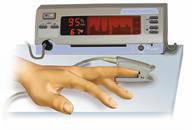ThisisPatientEngagementcontent
Pulse Oximetry
Learn more about our Patient Engagement products now! Turn your patients into active participants in their healthcare by giving them easy access to the same evidence-based information you trust – but delivered in an easy-to-understand format.

Pulse oximetry is a way to measure the oxygen level in your blood without a blood test. It uses a sensor called a pulse oximeter. It also tracks your heart rate.
A pulse oximeter can show you:Your health care provider will talk with you about risks. You may get skin sores if the sensor is left in the same spot for too long. But this is rare.
If a more accurate result is needed, you may have a blood test done.
This information is not intended to replace advice given to you by your health care provider. Make sure you discuss any questions you have with your health care provider.
Cookies are used by this site. To decline or learn more, visit our cookie notice.
Copyright © 2025 Elsevier, its licensors, and contributors. All rights are reserved, including those for text and data mining, AI training, and similar technologies.